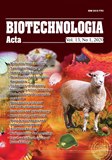ISSN 2410-776X (Online)
ISSN 2410-7751 (Print)

Biotechnologia Acta V. 13, No 1, 2020
P. 38-44, Bibliography 15, English
Universal Decimal Classification:: 579.842.21:615.331:579.61
https://doi.org/10.15407/biotech13.01.038
Bogomolets National Medical University, Kyiv, Ukraine
The work was aimed to study the synergy of the antimicrobial activity of the prodigiosin pigment with antibiotics against bacteria of the genera Bacillus, Staphylococcus and Streptococcus. The serial dilution method was used to evaluate antimicrobial compositions, which included inhibitors of cell wall synthesis: ampicillin, benzylpenicillin, vancomycin, cefazolin, and metronidazole (nitroimidazole derivatives) in combination with the pigment prodigiosin isolated from Serratia marcescens. Each combination was tested against the studied strains. The fractional inhibitory concentration index (FICI) for each combination was calculated to determine synergy, and the results were interpreted as follows: FICI ?0.5 ? synergism; FICI > 4.0 ? antagonism; and FICI > 0.5-4 ? neutralism.
It was shown that the ethanol extract of prodigiosin in combination with benzylpenicillin, vancomycin, cefazolin, and metronidazole interacted differently synergistically depending on the type of microorganism. The combinations of prodigiosin and metronidazole showed a synergistic effect against Bacillus subtilis, vancomycin and cefazolin against Staphylococcus aureus and benzylpenicillin against Streptococcus pyogenes. Other combinations of prodigiosin and antibiotics showed a neutral effect, and in the case of cefazolin against Str. pyogenes, even an antagonistic effect.
Thus, the study showed the synergism of prodigiosin with antibiotics depending on the type of microorganism, contributed to a several-fold decrease in the minimum inhibitory and bactericidal concentrations of each component separately, and the results indicated that prodigiosin acted separately more efficiently against gram-positive non-spore-forming bacteria. This synergistic combination of antimicrobial agents had great potency to prevent bacterial resistance.
Key words: prodigiosin, antimicrobial compounds, antimicrobial synergy.
© Palladin Institute of Biochemistry of National Academy of Sciences of Ukraine, 2020
References
1. Stankovic N., Senerovic L., Ilic-Tomic T., Vasiljevic B., Nikodinovic-Runic J. Properties and applications of undecylprodigiosin and other bacterial prodigiosins. Appl Microbiol Biotechnol. 2014, 98 (9), 3841–3858. https://doi.org/10.1007/s00253-014-5590-1
2. Williamson N. R., Fineran P. C., Leeper F. J., Salmond G. P. C. The biosynthesis and regulation of bacterial prodiginines. Nat. Rev. Microbiol. 2006, V. 4, P. 887–899. https://doi.org/10.1038/nrmicro1531
3. Darshan N., Manonmani H. K. Prodigiosin and its potential applications. J. Food Sci. Technol. 2015, 52 (9), 5393–5407. https://doi.org/10.1007/s13197-015-1740-4
4. Li D., Liu J., Wang X., Kong D., Du W., Li H., Hse C. Y., Shupe T., Zhou D., Zhao K. Biological potential and mechanism of prodigiosin from Serratia marcescens subsp. lawsoniana in Human choriocarcinoma and prostate cancer cell lines. Int. J. Mol. Sci. 2018, 19 (11). https://doi.org/10.3390/ijms19113465
5. Suryawanshi R. K., Patil C. D., Borase H. P., Salunke B. K., Patil S. V. Studies on production and biological potential of prodigiosin by Serratia marcescens. Appl. Biochem. Biotechnol. 2014, 173 (5), 1209–1221. https://doi.org/10.1007/s12010-014-0921-3
6. Danev?i? T., Vezjak M. B., Zorec M., Stopar D. Prodigiosin – a multifaceted Escherichia coli antimicrobial agent. PLoS One. 2016, 11 (9), 9–15. https://doi.org/10.1371/journal.pone.0162412
7. Herr?ez R., Mur A., Merlos A., Vi?as M., Vinuesa T. Using prodigiosin against some gram-positive and gram-negative bacteria and Trypanosoma cruzi. J. Venom. Anim. Toxins Incl. Trop. Dis. 2019, V. 25, P. e20190001. https://doi.org/10.1590/1678-9199-jvatitd-2019-0001
8. Tyers M., Wright G. D. Drug combinations: a strategy to extend the life of antibiotics in the 21st century. Nat. Rev. Microbiol. 2019, 17 (3), 141–155. https://doi.org/10.1038/s41579-018-0141-x
9. Cottarel G., Wierzbowski J. Combination drugs, an emerging option for antibacterial therapy. Trends Biotechnol. 2007, 25 (12), 547–555. https://doi.org/10.1016/j.tibtech.2007.09.004
10. Srimathi R., Priya R., Nirmala M., Malarvizhi A. Isolation, identification, optimization of prodigiosin pigment produced by Serratia marcescens. IJLEMR. 2017, 2 (9), 11–21.
11. Phatake Y. B., Dharmadhikari S. M. Isolation and screening of prodigiosin production bacteria and characterization of produced pigment. IJSN. 2016, 7 (1), 202–209.
12. Sathishkumar T., Aparna H. Original research article anti-biofouling activity of prodigiosin, a pigment extracted from Serratia marcescens. Int. J. Curr. Microbiol. App. Sci. 2014, 3 (5), 712–725.
13. Wayne P. A. Clinical and Laboratory Standards Institute (CLSI). Performance standards for antimicrobial susceptibility testing. 29th ed. CLSI supplement M100-S18, 2018.
14. Xuejie X., Li X., Ganjun Y., Yimin W., Yunqiu Q., Meijing Z. Synergistic combination of two antimicrobial agents closing each other’s mutant selection windows to prevent antimicrobial resistance. Sci. Rep. 2018, 8 (1), 7237. https://doi.org/10.1038/s41598-018-25714-z
15. Colquhoun D. The reproducibility of research and the misinterpretation of P-values. R. Soc. Open. Sci. 2017, 4 (12), 171085. https://doi.org/10.1098/rsos.171085

